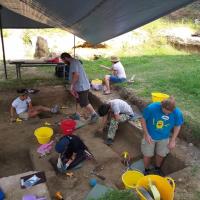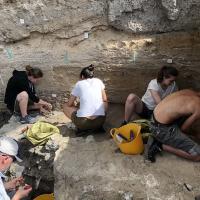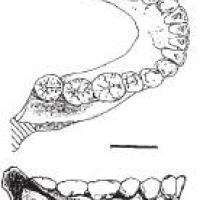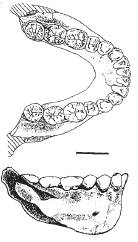Latest News






|
|
Gabunia & Vekua published a paper A Plio-Pleistocene hominid from Dmanisi, East Georgia, Caucasus in Nature, saying that the excavation season 1991 unearthed a well preserved early human mandible aged between 1.8 and 1.6 million years ago and belonging to species Homo erectus, which is the earliest known representative in western Eurasia.
Abstract
 ARCHAEOLOGICAL excavations at the mediaeval site of Dmanisi (East Georgia) revealed that the town was built on a series of deposits yielding Late Villafranchian mammalian fossils and led to the discovery in late 1991 of a well preserved early human mandible. Dmanisi, where excavations are being carried out by a joint expedition of the Archaeological Research Centre of the Georgian Academy of Sciences and the Römisch-Germanisches Zentralmuseum (Mainz, Germany), is located southwest of Tbilisi, at about 44o 20' N, 41o 20' E (Fig. 1). The fossils date to the latest Pliocene (or perhaps to the earliest Pleistocene), probably between 1.8 and 1.6 million years ago (Myr). Here we identify the mandible as belonging to the species Homo erectus, of which it is the earliest known representative in western Eurasia. It shows a number of similarities to the African and Chinese representatives of this species.
ARCHAEOLOGICAL excavations at the mediaeval site of Dmanisi (East Georgia) revealed that the town was built on a series of deposits yielding Late Villafranchian mammalian fossils and led to the discovery in late 1991 of a well preserved early human mandible. Dmanisi, where excavations are being carried out by a joint expedition of the Archaeological Research Centre of the Georgian Academy of Sciences and the Römisch-Germanisches Zentralmuseum (Mainz, Germany), is located southwest of Tbilisi, at about 44o 20' N, 41o 20' E (Fig. 1). The fossils date to the latest Pliocene (or perhaps to the earliest Pleistocene), probably between 1.8 and 1.6 million years ago (Myr). Here we identify the mandible as belonging to the species Homo erectus, of which it is the earliest known representative in western Eurasia. It shows a number of similarities to the African and Chinese representatives of this species.
